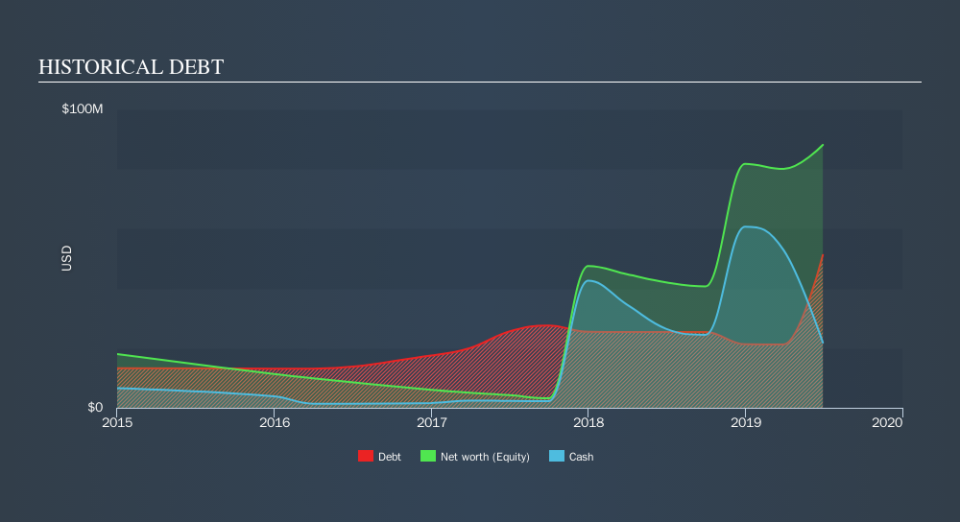Is OrthoPediatrics (NASDAQ:KIDS) Using Too Much Debt?

Warren Buffett famously said, 'Volatility is far from synonymous with risk.' So it might be obvious that you need to consider debt, when you think about how risky any given stock is, because too much debt can sink a company. Importantly, OrthoPediatrics Corp. (NASDAQ:KIDS) does carry debt. But the more important question is: how much risk is that debt creating?
Why Does Debt Bring Risk?
Debt assists a business until the business has trouble paying it off, either with new capital or with free cash flow. Ultimately, if the company can't fulfill its legal obligations to repay debt, shareholders could walk away with nothing. While that is not too common, we often do see indebted companies permanently diluting shareholders because lenders force them to raise capital at a distressed price. Of course, the upside of debt is that it often represents cheap capital, especially when it replaces dilution in a company with the ability to reinvest at high rates of return. The first step when considering a company's debt levels is to consider its cash and debt together.
View our latest analysis for OrthoPediatrics
What Is OrthoPediatrics's Debt?
You can click the graphic below for the historical numbers, but it shows that as of June 2019 OrthoPediatrics had US$51.2m of debt, an increase on US$25.4m, over one year. On the flip side, it has US$21.9m in cash leading to net debt of about US$29.4m.
A Look At OrthoPediatrics's Liabilities
According to the last reported balance sheet, OrthoPediatrics had liabilities of US$42.2m due within 12 months, and liabilities of US$21.2m due beyond 12 months. On the other hand, it had cash of US$21.9m and US$15.5m worth of receivables due within a year. So its liabilities outweigh the sum of its cash and (near-term) receivables by US$26.0m.
Of course, OrthoPediatrics has a market capitalization of US$550.5m, so these liabilities are probably manageable. Having said that, it's clear that we should continue to monitor its balance sheet, lest it change for the worse. When analysing debt levels, the balance sheet is the obvious place to start. But ultimately the future profitability of the business will decide if OrthoPediatrics can strengthen its balance sheet over time. So if you want to see what the professionals think, you might find this free report on analyst profit forecasts to be interesting.
Over 12 months, OrthoPediatrics reported revenue of US$63m, which is a gain of 23%. With any luck the company will be able to grow its way to profitability.
Caveat Emptor
Despite the top line growth, OrthoPediatrics still had negative earnings before interest and tax (EBIT), over the last year. Indeed, it lost US$7.0m at the EBIT level. When we look at that and recall the liabilities on its balance sheet, relative to cash, it seems unwise to us for the company to have any debt. Quite frankly we think the balance sheet is far from match-fit, although it could be improved with time. Another cause for caution is that is bled US$24m in negative free cash flow over the last twelve months. So to be blunt we think it is risky. For riskier companies like OrthoPediatrics I always like to keep an eye on the long term profit and revenue trends. Fortunately, you can click to see our interactive graph of its profit, revenue, and operating cashflow.
If you're interested in investing in businesses that can grow profits without the burden of debt, then check out this free list of growing businesses that have net cash on the balance sheet.
We aim to bring you long-term focused research analysis driven by fundamental data. Note that our analysis may not factor in the latest price-sensitive company announcements or qualitative material.
If you spot an error that warrants correction, please contact the editor at editorial-team@simplywallst.com. This article by Simply Wall St is general in nature. It does not constitute a recommendation to buy or sell any stock, and does not take account of your objectives, or your financial situation. Simply Wall St has no position in the stocks mentioned. Thank you for reading.

 Yahoo Finance
Yahoo Finance 
